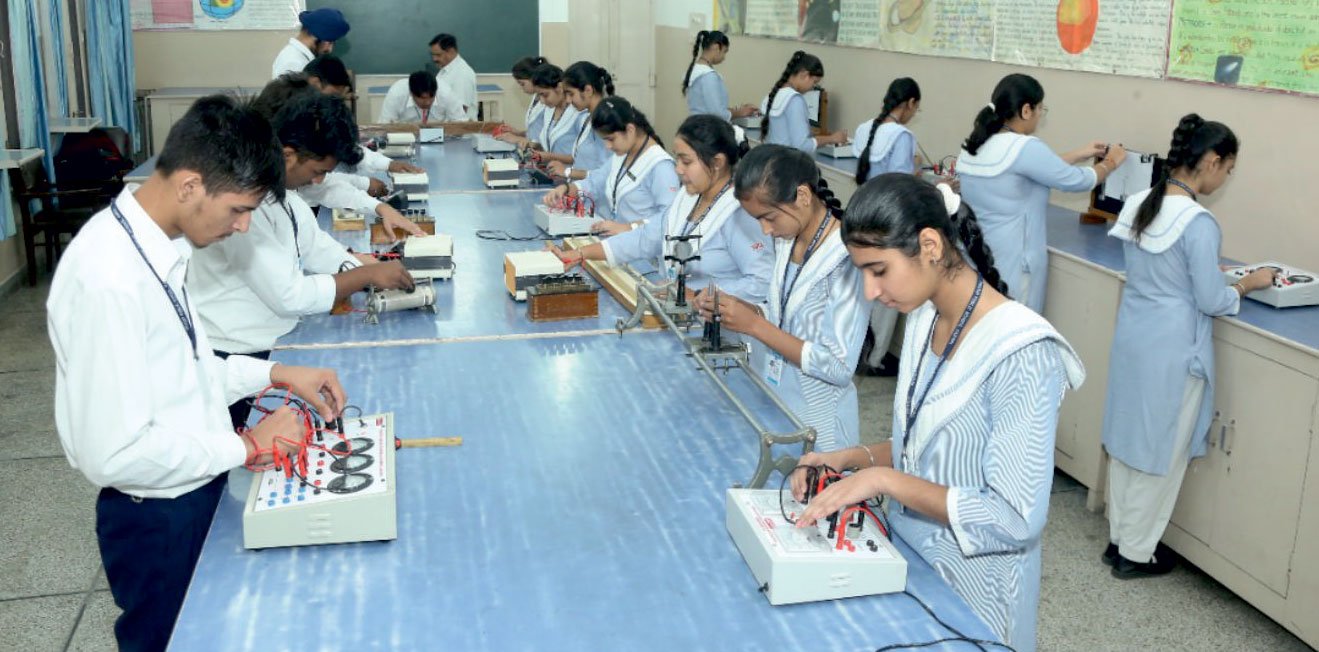HIGHLIGHTS OF THE MONTH
- Labour Day Celebration
- National Principal's Day Celebration
- Hindi Poem Recitation Competition (VII - VIII)
- Mothers Day Talk
- UT Exams
CBSE RESULT HIGHLIGHTS 2023-24
SCHOOL TOPPERS
First - AARUSHI BANSAL- 98.6%
Second -NIKUNJ, SPARSH GARG- 97.2 %
Third - JANNAT -97%
11 Students Scored Cent - Percent in Various Subjects.
STREAM WISE TOPPERS
COMMERCE:
First: Aarushi Bansal - 98.6%
Second: Nikunj - 97.2%
Second: Sparsh Garg - 97.2%
Third: Jai Mehendiratta - 96.2%
NON MEDICAL:
First: Dhanya Manocha - 95.8%
Second: Daksh Dudeja - 94.0%
Third: Jatin - 92.6%
MEDICAL:
First: Arpita - 94.8%
Second: Samarveer Singh - 93.8%
Third: Harshiv Dhingra - 90.6%
HUMANITIES:
First: Jannat - 97.0%
Second: Sanchita - 93.8%
Third: Mannat Nagpal - 92.6%
SUBJECT WISE TOPPERS
ACCOUNTANCY- 100
1.SPARSH GARG
2.PAVITRA
PAINTING- 100
1.JANNAT
2.SAKSHAM
3.ISHITA GARG
4.AYUSH PANDEY
5.DIVYAM NANDA
6.EKANSH SUKHIJA
7.AARUSHI BANSAL
8.BHAVISH GROVER
ECONOMICS- 100
1.SPARSH GARG
BUSINESS STUDIES - 99
1.SPARSH GARG
2.MUSKAAN GUPTA
3.VRINDA GARG
4.PARI TANEJA
ENGLISH-99
1.YASHASVI
2.ARUNIMA BHATIA
3.ANSHULA BANSAL
PSYCHOLOGY- 99
1. JANNAT
COMPUTER SCIENCE- 98
1. AADITYA ARORA
MATHEMATICS- 96
1. DHANYA MANOCHA
2. JAI MEHNDIRATTA
MUSIC-96
1. JANNAT
PHYSICAL EDUCATION- 96
1. DHANYA MANOCHA
CHEMISTRY-96
1. DHANYA MANOCHA
POLITICAL SCIENCE - 96
1. JANNAT
PHYSICS-95
1. SAMARVEER SINGH
BIOLOGY-95
1. SAMARVEER SINGH
2. HARSHIV DHINGRA
GEOGRAPHY - 95
1. SIDDHARTH
HINDI - 94
1. JANNAT
School Toppers - X
First - PARAS SAROHA- 97.4%
Second - DIVIJAA- 97%
Third - CHETANYE VASHIST- 96%
9 STUDENTS SCORED CENT - PERCENT IN VARIOUS SUBJECTS.
MATHEMATICS
1. DIVIJAA-100
2. TANUSHI JAIN-100
3. KESHAV GUPTA-100
4. TANISHA-100
ARTIFICIAL INTELLIGENCE -
1. PARAS SAROHA-100
2. CHETANYE VASHIST-100
3. YUVANSH CHAUHAN-100-
4. SHIVAM GARG-100
5. ANAMIKA SACHDEVA-100
HIGHLIGHTS OF THE MONTH
- Labour Day Celebration
- National Principal's Day Celebration
- Hindi Poem Recitation Competition (VII - VIII)
- Mothers Day Talk
- UT Exams
CBSE RESULT HIGHLIGHTS 2023-24
SCHOOL TOPPERS
First - AARUSHI BANSAL- 98.6%
Second -NIKUNJ, SPARSH GARG- 97.2 %
Third - JANNAT -97%
11 Students Scored Cent - Percent in Various Subjects.
STREAM WISE TOPPERS
COMMERCE:
First: Aarushi Bansal - 98.6%
Second: Nikunj - 97.2%
Second: Sparsh Garg - 97.2%
Third: Jai Mehendiratta - 96.2%
NON MEDICAL:
First: Dhanya Manocha - 95.8%
Second: Daksh Dudeja - 94.0%
Third: Jatin - 92.6%
MEDICAL:
First: Arpita - 94.8%
Second: Samarveer Singh - 93.8%
Third: Harshiv Dhingra - 90.6%
HUMANITIES:
First: Jannat - 97.0%
Second: Sanchita - 93.8%
Third: Mannat Nagpal - 92.6%
SUBJECT WISE TOPPERS
ACCOUNTANCY- 100
1.SPARSH GARG
2.PAVITRA
PAINTING- 100
1.JANNAT
2.SAKSHAM
3.ISHITA GARG
4.AYUSH PANDEY
5.DIVYAM NANDA
6.EKANSH SUKHIJA
7.AARUSHI BANSAL
8.BHAVISH GROVER
ECONOMICS- 100
1.SPARSH GARG
BUSINESS STUDIES - 99
1.SPARSH GARG
2.MUSKAAN GUPTA
3.VRINDA GARG
4.PARI TANEJA
ENGLISH-99
1.YASHASVI
2.ARUNIMA BHATIA
3.ANSHULA BANSAL
PSYCHOLOGY- 99
1. JANNAT
COMPUTER SCIENCE- 98
1. AADITYA ARORA
MATHEMATICS- 96
1. DHANYA MANOCHA
2. JAI MEHNDIRATTA
MUSIC-96
1. JANNAT
PHYSICAL EDUCATION- 96
1. DHANYA MANOCHA
CHEMISTRY-96
1. DHANYA MANOCHA
POLITICAL SCIENCE - 96
1. JANNAT
PHYSICS-95
1. SAMARVEER SINGH
BIOLOGY-95
1. SAMARVEER SINGH
2. HARSHIV DHINGRA
GEOGRAPHY - 95
1. SIDDHARTH
HINDI - 94
1. JANNAT
School Toppers - X
First - PARAS SAROHA- 97.4%
Second - DIVIJAA- 97%
Third - CHETANYE VASHIST- 96%
9 STUDENTS SCORED CENT - PERCENT IN VARIOUS SUBJECTS.
MATHEMATICS
1. DIVIJAA-100
2. TANUSHI JAIN-100
3. KESHAV GUPTA-100
4. TANISHA-100
ARTIFICIAL INTELLIGENCE -
1. PARAS SAROHA-100
2. CHETANYE VASHIST-100
3. YUVANSH CHAUHAN-100-
4. SHIVAM GARG-100
5. ANAMIKA SACHDEVA-100
HIGHLIGHTS OF THE MONTH
- Labour Day Celebration
- National Principal's Day Celebration
- Hindi Poem Recitation Competition (VII - VIII)
- Mothers Day Talk
- UT Exams
CBSE RESULT HIGHLIGHTS 2023-24
SCHOOL TOPPERS
First - AARUSHI BANSAL- 98.6%
Second -NIKUNJ, SPARSH GARG- 97.2 %
Third - JANNAT -97%
11 Students Scored Cent - Percent in Various Subjects.
STREAM WISE TOPPERS
COMMERCE:
First: Aarushi Bansal - 98.6%
Second: Nikunj - 97.2%
Second: Sparsh Garg - 97.2%
Third: Jai Mehendiratta - 96.2%
NON MEDICAL:
First: Dhanya Manocha - 95.8%
Second: Daksh Dudeja - 94.0%
Third: Jatin - 92.6%
MEDICAL:
First: Arpita - 94.8%
Second: Samarveer Singh - 93.8%
Third: Harshiv Dhingra - 90.6%
HUMANITIES:
First: Jannat - 97.0%
Second: Sanchita - 93.8%
Third: Mannat Nagpal - 92.6%
SUBJECT WISE TOPPERS
ACCOUNTANCY- 100
1.SPARSH GARG
2.PAVITRA
PAINTING- 100
1.JANNAT
2.SAKSHAM
3.ISHITA GARG
4.AYUSH PANDEY
5.DIVYAM NANDA
6.EKANSH SUKHIJA
7.AARUSHI BANSAL
8.BHAVISH GROVER
ECONOMICS- 100
1.SPARSH GARG
BUSINESS STUDIES - 99
1.SPARSH GARG
2.MUSKAAN GUPTA
3.VRINDA GARG
4.PARI TANEJA
ENGLISH-99
1.YASHASVI
2.ARUNIMA BHATIA
3.ANSHULA BANSAL
PSYCHOLOGY- 99
1. JANNAT
COMPUTER SCIENCE- 98
1. AADITYA ARORA
MATHEMATICS- 96
1. DHANYA MANOCHA
2. JAI MEHNDIRATTA
MUSIC-96
1. JANNAT
PHYSICAL EDUCATION- 96
1. DHANYA MANOCHA
CHEMISTRY-96
1. DHANYA MANOCHA
POLITICAL SCIENCE - 96
1. JANNAT
PHYSICS-95
1. SAMARVEER SINGH
BIOLOGY-95
1. SAMARVEER SINGH
2. HARSHIV DHINGRA
GEOGRAPHY - 95
1. SIDDHARTH
HINDI - 94
1. JANNAT
School Toppers - X
First - PARAS SAROHA- 97.4%
Second - DIVIJAA- 97%
Third - CHETANYE VASHIST- 96%
9 STUDENTS SCORED CENT - PERCENT IN VARIOUS SUBJECTS.
MATHEMATICS
1. DIVIJAA-100
2. TANUSHI JAIN-100
3. KESHAV GUPTA-100
4. TANISHA-100
ARTIFICIAL INTELLIGENCE -
1. PARAS SAROHA-100
2. CHETANYE VASHIST-100
3. YUVANSH CHAUHAN-100-
4. SHIVAM GARG-100
5. ANAMIKA SACHDEVA-100
HIGHLIGHTS OF THE MONTH
- Labour Day Celebration
- National Principal's Day Celebration
- Hindi Poem Recitation Competition (VII - VIII)
- Mothers Day Talk
- UT Exams
CBSE RESULT HIGHLIGHTS 2023-24
SCHOOL TOPPERS
First - AARUSHI BANSAL- 98.6%
Second -NIKUNJ, SPARSH GARG- 97.2 %
Third - JANNAT -97%
11 Students Scored Cent - Percent in Various Subjects.
STREAM WISE TOPPERS
COMMERCE:
First: Aarushi Bansal - 98.6%
Second: Nikunj - 97.2%
Second: Sparsh Garg - 97.2%
Third: Jai Mehendiratta - 96.2%
NON MEDICAL:
First: Dhanya Manocha - 95.8%
Second: Daksh Dudeja - 94.0%
Third: Jatin - 92.6%
MEDICAL:
First: Arpita - 94.8%
Second: Samarveer Singh - 93.8%
Third: Harshiv Dhingra - 90.6%
HUMANITIES:
First: Jannat - 97.0%
Second: Sanchita - 93.8%
Third: Mannat Nagpal - 92.6%
SUBJECT WISE TOPPERS
ACCOUNTANCY- 100
1.SPARSH GARG
2.PAVITRA
PAINTING- 100
1.JANNAT
2.SAKSHAM
3.ISHITA GARG
4.AYUSH PANDEY
5.DIVYAM NANDA
6.EKANSH SUKHIJA
7.AARUSHI BANSAL
8.BHAVISH GROVER
ECONOMICS- 100
1.SPARSH GARG
BUSINESS STUDIES - 99
1.SPARSH GARG
2.MUSKAAN GUPTA
3.VRINDA GARG
4.PARI TANEJA
ENGLISH-99
1.YASHASVI
2.ARUNIMA BHATIA
3.ANSHULA BANSAL
PSYCHOLOGY- 99
1. JANNAT
COMPUTER SCIENCE- 98
1. AADITYA ARORA
MATHEMATICS- 96
1. DHANYA MANOCHA
2. JAI MEHNDIRATTA
MUSIC-96
1. JANNAT
PHYSICAL EDUCATION- 96
1. DHANYA MANOCHA
CHEMISTRY-96
1. DHANYA MANOCHA
POLITICAL SCIENCE - 96
1. JANNAT
PHYSICS-95
1. SAMARVEER SINGH
BIOLOGY-95
1. SAMARVEER SINGH
2. HARSHIV DHINGRA
GEOGRAPHY - 95
1. SIDDHARTH
HINDI - 94
1. JANNAT
School Toppers - X
First - PARAS SAROHA- 97.4%
Second - DIVIJAA- 97%
Third - CHETANYE VASHIST- 96%
9 STUDENTS SCORED CENT - PERCENT IN VARIOUS SUBJECTS.
MATHEMATICS
1. DIVIJAA-100
2. TANUSHI JAIN-100
3. KESHAV GUPTA-100
4. TANISHA-100
ARTIFICIAL INTELLIGENCE -
1. PARAS SAROHA-100
2. CHETANYE VASHIST-100
3. YUVANSH CHAUHAN-100-
4. SHIVAM GARG-100
5. ANAMIKA SACHDEVA-100
HIGHLIGHTS OF THE MONTH
- Labour Day Celebration
- National Principal's Day Celebration
- Hindi Poem Recitation Competition (VII - VIII)
- Mothers Day Talk
- UT Exams
CBSE RESULT HIGHLIGHTS 2023-24
SCHOOL TOPPERS
First - AARUSHI BANSAL- 98.6%
Second -NIKUNJ, SPARSH GARG- 97.2 %
Third - JANNAT -97%
11 Students Scored Cent - Percent in Various Subjects.
STREAM WISE TOPPERS
COMMERCE:
First: Aarushi Bansal - 98.6%
Second: Nikunj - 97.2%
Second: Sparsh Garg - 97.2%
Third: Jai Mehendiratta - 96.2%
NON MEDICAL:
First: Dhanya Manocha - 95.8%
Second: Daksh Dudeja - 94.0%
Third: Jatin - 92.6%
MEDICAL:
First: Arpita - 94.8%
Second: Samarveer Singh - 93.8%
Third: Harshiv Dhingra - 90.6%
HUMANITIES:
First: Jannat - 97.0%
Second: Sanchita - 93.8%
Third: Mannat Nagpal - 92.6%
SUBJECT WISE TOPPERS
ACCOUNTANCY- 100
1.SPARSH GARG
2.PAVITRA
PAINTING- 100
1.JANNAT
2.SAKSHAM
3.ISHITA GARG
4.AYUSH PANDEY
5.DIVYAM NANDA
6.EKANSH SUKHIJA
7.AARUSHI BANSAL
8.BHAVISH GROVER
ECONOMICS- 100
1.SPARSH GARG
BUSINESS STUDIES - 99
1.SPARSH GARG
2.MUSKAAN GUPTA
3.VRINDA GARG
4.PARI TANEJA
ENGLISH-99
1.YASHASVI
2.ARUNIMA BHATIA
3.ANSHULA BANSAL
PSYCHOLOGY- 99
1. JANNAT
COMPUTER SCIENCE- 98
1. AADITYA ARORA
MATHEMATICS- 96
1. DHANYA MANOCHA
2. JAI MEHNDIRATTA
MUSIC-96
1. JANNAT
PHYSICAL EDUCATION- 96
1. DHANYA MANOCHA
CHEMISTRY-96
1. DHANYA MANOCHA
POLITICAL SCIENCE - 96
1. JANNAT
PHYSICS-95
1. SAMARVEER SINGH
BIOLOGY-95
1. SAMARVEER SINGH
2. HARSHIV DHINGRA
GEOGRAPHY - 95
1. SIDDHARTH
HINDI - 94
1. JANNAT
School Toppers - X
First - PARAS SAROHA- 97.4%
Second - DIVIJAA- 97%
Third - CHETANYE VASHIST- 96%
9 STUDENTS SCORED CENT - PERCENT IN VARIOUS SUBJECTS.
MATHEMATICS
1. DIVIJAA-100
2. TANUSHI JAIN-100
3. KESHAV GUPTA-100
4. TANISHA-100
ARTIFICIAL INTELLIGENCE -
1. PARAS SAROHA-100
2. CHETANYE VASHIST-100
3. YUVANSH CHAUHAN-100-
4. SHIVAM GARG-100
5. ANAMIKA SACHDEVA-100
HIGHLIGHTS OF THE MONTH
- Labour Day Celebration
- National Principal's Day Celebration
- Hindi Poem Recitation Competition (VII - VIII)
- Mothers Day Talk
- UT Exams
CBSE RESULT HIGHLIGHTS 2023-24
SCHOOL TOPPERS
First - AARUSHI BANSAL- 98.6%
Second -NIKUNJ, SPARSH GARG- 97.2 %
Third - JANNAT -97%
11 Students Scored Cent - Percent in Various Subjects.
STREAM WISE TOPPERS
COMMERCE:
First: Aarushi Bansal - 98.6%
Second: Nikunj - 97.2%
Second: Sparsh Garg - 97.2%
Third: Jai Mehendiratta - 96.2%
NON MEDICAL:
First: Dhanya Manocha - 95.8%
Second: Daksh Dudeja - 94.0%
Third: Jatin - 92.6%
MEDICAL:
First: Arpita - 94.8%
Second: Samarveer Singh - 93.8%
Third: Harshiv Dhingra - 90.6%
HUMANITIES:
First: Jannat - 97.0%
Second: Sanchita - 93.8%
Third: Mannat Nagpal - 92.6%
SUBJECT WISE TOPPERS
ACCOUNTANCY- 100
1.SPARSH GARG
2.PAVITRA
PAINTING- 100
1.JANNAT
2.SAKSHAM
3.ISHITA GARG
4.AYUSH PANDEY
5.DIVYAM NANDA
6.EKANSH SUKHIJA
7.AARUSHI BANSAL
8.BHAVISH GROVER
ECONOMICS- 100
1.SPARSH GARG
BUSINESS STUDIES - 99
1.SPARSH GARG
2.MUSKAAN GUPTA
3.VRINDA GARG
4.PARI TANEJA
ENGLISH-99
1.YASHASVI
2.ARUNIMA BHATIA
3.ANSHULA BANSAL
PSYCHOLOGY- 99
1. JANNAT
COMPUTER SCIENCE- 98
1. AADITYA ARORA
MATHEMATICS- 96
1. DHANYA MANOCHA
2. JAI MEHNDIRATTA
MUSIC-96
1. JANNAT
PHYSICAL EDUCATION- 96
1. DHANYA MANOCHA
CHEMISTRY-96
1. DHANYA MANOCHA
POLITICAL SCIENCE - 96
1. JANNAT
PHYSICS-95
1. SAMARVEER SINGH
BIOLOGY-95
1. SAMARVEER SINGH
2. HARSHIV DHINGRA
GEOGRAPHY - 95
1. SIDDHARTH
HINDI - 94
1. JANNAT
School Toppers - X
First - PARAS SAROHA- 97.4%
Second - DIVIJAA- 97%
Third - CHETANYE VASHIST- 96%
9 STUDENTS SCORED CENT - PERCENT IN VARIOUS SUBJECTS.
MATHEMATICS
1. DIVIJAA-100
2. TANUSHI JAIN-100
3. KESHAV GUPTA-100
4. TANISHA-100
ARTIFICIAL INTELLIGENCE -
1. PARAS SAROHA-100
2. CHETANYE VASHIST-100
3. YUVANSH CHAUHAN-100-
4. SHIVAM GARG-100
5. ANAMIKA SACHDEVA-100
HIGHLIGHTS OF THE MONTH
- Labour Day Celebration
- National Principal's Day Celebration
- Hindi Poem Recitation Competition (VII - VIII)
- Mothers Day Talk
- UT Exams
CBSE RESULT HIGHLIGHTS 2023-24
SCHOOL TOPPERS
First - AARUSHI BANSAL- 98.6%
Second -NIKUNJ, SPARSH GARG- 97.2 %
Third - JANNAT -97%
11 Students Scored Cent - Percent in Various Subjects.
STREAM WISE TOPPERS
COMMERCE:
First: Aarushi Bansal - 98.6%
Second: Nikunj - 97.2%
Second: Sparsh Garg - 97.2%
Third: Jai Mehendiratta - 96.2%
NON MEDICAL:
First: Dhanya Manocha - 95.8%
Second: Daksh Dudeja - 94.0%
Third: Jatin - 92.6%
MEDICAL:
First: Arpita - 94.8%
Second: Samarveer Singh - 93.8%
Third: Harshiv Dhingra - 90.6%
HUMANITIES:
First: Jannat - 97.0%
Second: Sanchita - 93.8%
Third: Mannat Nagpal - 92.6%
SUBJECT WISE TOPPERS
ACCOUNTANCY- 100
1.SPARSH GARG
2.PAVITRA
PAINTING- 100
1.JANNAT
2.SAKSHAM
3.ISHITA GARG
4.AYUSH PANDEY
5.DIVYAM NANDA
6.EKANSH SUKHIJA
7.AARUSHI BANSAL
8.BHAVISH GROVER
ECONOMICS- 100
1.SPARSH GARG
BUSINESS STUDIES - 99
1.SPARSH GARG
2.MUSKAAN GUPTA
3.VRINDA GARG
4.PARI TANEJA
ENGLISH-99
1.YASHASVI
2.ARUNIMA BHATIA
3.ANSHULA BANSAL
PSYCHOLOGY- 99
1. JANNAT
COMPUTER SCIENCE- 98
1. AADITYA ARORA
MATHEMATICS- 96
1. DHANYA MANOCHA
2. JAI MEHNDIRATTA
MUSIC-96
1. JANNAT
PHYSICAL EDUCATION- 96
1. DHANYA MANOCHA
CHEMISTRY-96
1. DHANYA MANOCHA
POLITICAL SCIENCE - 96
1. JANNAT
PHYSICS-95
1. SAMARVEER SINGH
BIOLOGY-95
1. SAMARVEER SINGH
2. HARSHIV DHINGRA
GEOGRAPHY - 95
1. SIDDHARTH
HINDI - 94
1. JANNAT
School Toppers - X
First - PARAS SAROHA- 97.4%
Second - DIVIJAA- 97%
Third - CHETANYE VASHIST- 96%
9 STUDENTS SCORED CENT - PERCENT IN VARIOUS SUBJECTS.
MATHEMATICS
1. DIVIJAA-100
2. TANUSHI JAIN-100
3. KESHAV GUPTA-100
4. TANISHA-100
ARTIFICIAL INTELLIGENCE -
1. PARAS SAROHA-100
2. CHETANYE VASHIST-100
3. YUVANSH CHAUHAN-100-
4. SHIVAM GARG-100
5. ANAMIKA SACHDEVA-100
HIGHLIGHTS OF THE MONTH
- Labour Day Celebration
- National Principal's Day Celebration
- Hindi Poem Recitation Competition (VII - VIII)
- Mothers Day Talk
- UT Exams
CBSE RESULT HIGHLIGHTS 2023-24
SCHOOL TOPPERS
First - AARUSHI BANSAL- 98.6%
Second -NIKUNJ, SPARSH GARG- 97.2 %
Third - JANNAT -97%
11 Students Scored Cent - Percent in Various Subjects.
STREAM WISE TOPPERS
COMMERCE:
First: Aarushi Bansal - 98.6%
Second: Nikunj - 97.2%
Second: Sparsh Garg - 97.2%
Third: Jai Mehendiratta - 96.2%
NON MEDICAL:
First: Dhanya Manocha - 95.8%
Second: Daksh Dudeja - 94.0%
Third: Jatin - 92.6%
MEDICAL:
First: Arpita - 94.8%
Second: Samarveer Singh - 93.8%
Third: Harshiv Dhingra - 90.6%
HUMANITIES:
First: Jannat - 97.0%
Second: Sanchita - 93.8%
Third: Mannat Nagpal - 92.6%
SUBJECT WISE TOPPERS
ACCOUNTANCY- 100
1.SPARSH GARG
2.PAVITRA
PAINTING- 100
1.JANNAT
2.SAKSHAM
3.ISHITA GARG
4.AYUSH PANDEY
5.DIVYAM NANDA
6.EKANSH SUKHIJA
7.AARUSHI BANSAL
8.BHAVISH GROVER
ECONOMICS- 100
1.SPARSH GARG
BUSINESS STUDIES - 99
1.SPARSH GARG
2.MUSKAAN GUPTA
3.VRINDA GARG
4.PARI TANEJA
ENGLISH-99
1.YASHASVI
2.ARUNIMA BHATIA
3.ANSHULA BANSAL
PSYCHOLOGY- 99
1. JANNAT
COMPUTER SCIENCE- 98
1. AADITYA ARORA
MATHEMATICS- 96
1. DHANYA MANOCHA
2. JAI MEHNDIRATTA
MUSIC-96
1. JANNAT
PHYSICAL EDUCATION- 96
1. DHANYA MANOCHA
CHEMISTRY-96
1. DHANYA MANOCHA
POLITICAL SCIENCE - 96
1. JANNAT
PHYSICS-95
1. SAMARVEER SINGH
BIOLOGY-95
1. SAMARVEER SINGH
2. HARSHIV DHINGRA
GEOGRAPHY - 95
1. SIDDHARTH
HINDI - 94
1. JANNAT
School Toppers - X
First - PARAS SAROHA- 97.4%
Second - DIVIJAA- 97%
Third - CHETANYE VASHIST- 96%
9 STUDENTS SCORED CENT - PERCENT IN VARIOUS SUBJECTS.
MATHEMATICS
1. DIVIJAA-100
2. TANUSHI JAIN-100
3. KESHAV GUPTA-100
4. TANISHA-100
ARTIFICIAL INTELLIGENCE -
1. PARAS SAROHA-100
2. CHETANYE VASHIST-100
3. YUVANSH CHAUHAN-100-
4. SHIVAM GARG-100
5. ANAMIKA SACHDEVA-100
 The impacts of natural and human-induced hazards are increasing with population growth and climate change, causing immense losses to the society. Besides their impact on the society and infrastructure, disasters are also one of the biggest challenges to the goal of ‘Education for All’. In the past couple of decades, a number of disasters killed thousands of school children and severely disrupted the normal education in many countries.
The impacts of natural and human-induced hazards are increasing with population growth and climate change, causing immense losses to the society. Besides their impact on the society and infrastructure, disasters are also one of the biggest challenges to the goal of ‘Education for All’. In the past couple of decades, a number of disasters killed thousands of school children and severely disrupted the normal education in many countries.






